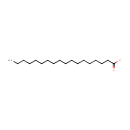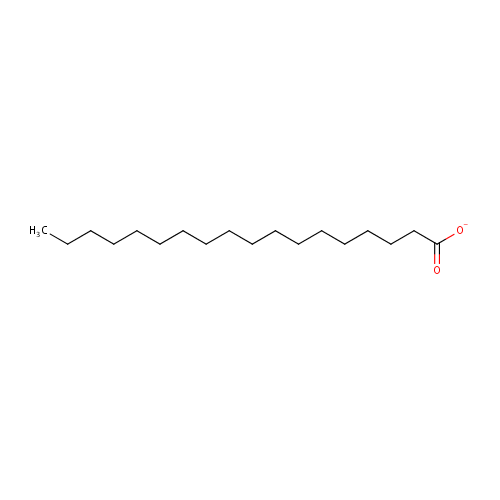
Octadecanoate (N-C18:0) (PAMDB001745)
| Record Information | ||||||||||||||||||||||||||||||||||||||||||||||||||||||||||
|---|---|---|---|---|---|---|---|---|---|---|---|---|---|---|---|---|---|---|---|---|---|---|---|---|---|---|---|---|---|---|---|---|---|---|---|---|---|---|---|---|---|---|---|---|---|---|---|---|---|---|---|---|---|---|---|---|---|---|
| Version | 1.0 | |||||||||||||||||||||||||||||||||||||||||||||||||||||||||
| Update Date | 1/22/2018 11:54:54 AM | |||||||||||||||||||||||||||||||||||||||||||||||||||||||||
| Metabolite ID | PAMDB001745 | |||||||||||||||||||||||||||||||||||||||||||||||||||||||||
| Identification | ||||||||||||||||||||||||||||||||||||||||||||||||||||||||||
| Name: | Octadecanoate (N-C18:0) | |||||||||||||||||||||||||||||||||||||||||||||||||||||||||
| Description: | Octadecanoate (n-c18:0) belongs to the class of Straight Chain Fatty Acids. These are fatty acids with a straight aliphatic chain. (inferred from compound structure)Stearic acid (STAIR-ik or STEER-ik) is the saturated fatty acid with an 18 carbon chain and has the IUPAC name octadecanoic acid. It is a waxy solid, and its chemical formula is CH3(CH2)16CO2H. Its name comes from the Greek word ???α? st?ar, which means tallow. The salts and esters of stearic acid are called stearates. Stearic acid is one of the most common saturated fatty acids found in nature following palmitic acid. (WikiPedia) | |||||||||||||||||||||||||||||||||||||||||||||||||||||||||
| Structure | ||||||||||||||||||||||||||||||||||||||||||||||||||||||||||
| Synonyms: |
| |||||||||||||||||||||||||||||||||||||||||||||||||||||||||
| Chemical Formula: | C18H35O2 | |||||||||||||||||||||||||||||||||||||||||||||||||||||||||
| Average Molecular Weight: | 283.4693 | |||||||||||||||||||||||||||||||||||||||||||||||||||||||||
| Monoisotopic Molecular Weight: | 283.263705364 | |||||||||||||||||||||||||||||||||||||||||||||||||||||||||
| InChI Key: | QIQXTHQIDYTFRH-UHFFFAOYSA-M | |||||||||||||||||||||||||||||||||||||||||||||||||||||||||
| InChI: | InChI=1S/C18H36O2/c1-2-3-4-5-6-7-8-9-10-11-12-13-14-15-16-17-18(19)20/h2-17H2,1H3,(H,19,20)/p-1 | |||||||||||||||||||||||||||||||||||||||||||||||||||||||||
| CAS number: | Not Available | |||||||||||||||||||||||||||||||||||||||||||||||||||||||||
| IUPAC Name: | octadecanoate | |||||||||||||||||||||||||||||||||||||||||||||||||||||||||
| Traditional IUPAC Name: | n-octadecanoate | |||||||||||||||||||||||||||||||||||||||||||||||||||||||||
| SMILES: | CCCCCCCCCCCCCCCCCC([O-])=O | |||||||||||||||||||||||||||||||||||||||||||||||||||||||||
| Chemical Taxonomy | ||||||||||||||||||||||||||||||||||||||||||||||||||||||||||
| Taxonomy Description | This compound belongs to the class of organic compounds known as long-chain fatty acids. These are fatty acids with an aliphatic tail that contains between 13 and 21 carbon atoms. | |||||||||||||||||||||||||||||||||||||||||||||||||||||||||
| Kingdom | Organic compounds | |||||||||||||||||||||||||||||||||||||||||||||||||||||||||
| Super Class | Lipids and lipid-like molecules | |||||||||||||||||||||||||||||||||||||||||||||||||||||||||
| Class | Fatty Acyls | |||||||||||||||||||||||||||||||||||||||||||||||||||||||||
| Sub Class | Fatty acids and conjugates | |||||||||||||||||||||||||||||||||||||||||||||||||||||||||
| Direct Parent | Long-chain fatty acids | |||||||||||||||||||||||||||||||||||||||||||||||||||||||||
| Alternative Parents | ||||||||||||||||||||||||||||||||||||||||||||||||||||||||||
| Substituents |
| |||||||||||||||||||||||||||||||||||||||||||||||||||||||||
| Molecular Framework | Aliphatic acyclic compounds | |||||||||||||||||||||||||||||||||||||||||||||||||||||||||
| External Descriptors |
| |||||||||||||||||||||||||||||||||||||||||||||||||||||||||
| Physical Properties | ||||||||||||||||||||||||||||||||||||||||||||||||||||||||||
| State: | Not Available | |||||||||||||||||||||||||||||||||||||||||||||||||||||||||
| Charge: | -1 | |||||||||||||||||||||||||||||||||||||||||||||||||||||||||
| Melting point: | Not Available | |||||||||||||||||||||||||||||||||||||||||||||||||||||||||
| Experimental Properties: |
| |||||||||||||||||||||||||||||||||||||||||||||||||||||||||
| Predicted Properties |
| |||||||||||||||||||||||||||||||||||||||||||||||||||||||||
| Biological Properties | ||||||||||||||||||||||||||||||||||||||||||||||||||||||||||
| Cellular Locations: | Membrane | |||||||||||||||||||||||||||||||||||||||||||||||||||||||||
| Reactions: | Adenosine triphosphate + Coenzyme A + Hydrogen ion + Octadecanoate (N-C18:0) > Adenosine monophosphate + Hydrogen ion + Pyrophosphate + Stearoyl-CoA acyl carrier protein + Adenosine triphosphate + Octadecanoate (N-C18:0) > Adenosine monophosphate + Octadecanoyl-ACP (n-C18:0ACP) + Pyrophosphate Water + Stearoyl-CoA > Coenzyme A + Hydrogen ion + Octadecanoate (N-C18:0) 1-Acyl-sn-glycero-3-phosphoethanolamine (N-C18:0) + Water > Glycerylphosphorylethanolamine + Hydrogen ion + Octadecanoate (N-C18:0) 1-Acyl-sn-glycero-3-phosphoglycerol (N-C18:0) + Water > Glycerophosphoglycerol + Hydrogen ion + Octadecanoate (N-C18:0) 1-Octadecanoyl-sn-glycerol 3-phosphate + Water > Glycerol 3-phosphate + Hydrogen ion + Octadecanoate (N-C18:0) Water + Octadecanoyl-phosphate (n-C18:0) >2 Hydrogen ion + Octadecanoate (N-C18:0) + Phosphate 2-Acyl-sn-glycero-3-phosphoethanolamine (N-C18:0) + Adenosine triphosphate + Octadecanoate (N-C18:0) > Adenosine monophosphate + PE(14:0/14:0) + Pyrophosphate 2-Acyl-sn-glycero-3-phosphoglycerol (N-C18:0) + Adenosine triphosphate + Octadecanoate (N-C18:0) > Adenosine monophosphate + PG(18:0/18:0) + Pyrophosphate Water + PA(16:0/16:0) > 1-Octadecanoyl-sn-glycerol 3-phosphate + Hydrogen ion + Octadecanoate (N-C18:0) Water + PA(16:0/16:0) > 2-octadecanoyl-sn-glycerol 3-phosphate + Octadecanoate (N-C18:0) Water + PE(14:0/14:0) > 1-Acyl-sn-glycero-3-phosphoethanolamine (N-C18:0) + Hydrogen ion + Octadecanoate (N-C18:0) Water + PE(14:0/14:0) > 2-Acyl-sn-glycero-3-phosphoethanolamine (N-C18:0) + Hydrogen ion + Octadecanoate (N-C18:0) Water + PG(18:0/18:0) > 1-Acyl-sn-glycero-3-phosphoglycerol (N-C18:0) + Hydrogen ion + Octadecanoate (N-C18:0) Water + PG(18:0/18:0) > 2-Acyl-sn-glycero-3-phosphoglycerol (N-C18:0) + Hydrogen ion + Octadecanoate (N-C18:0) 2-Acyl-sn-glycero-3-phosphoethanolamine (N-C18:0) + Water > Glycerylphosphorylethanolamine + Hydrogen ion + Octadecanoate (N-C18:0) 2-Acyl-sn-glycero-3-phosphoglycerol (N-C18:0) + Water > Glycerophosphoglycerol + Hydrogen ion + Octadecanoate (N-C18:0) 2-octadecanoyl-sn-glycerol 3-phosphate + Water > Glycerol 3-phosphate +2 Hydrogen ion + Octadecanoate (N-C18:0) | |||||||||||||||||||||||||||||||||||||||||||||||||||||||||
| Pathways: | Not Available | |||||||||||||||||||||||||||||||||||||||||||||||||||||||||
| Spectra | ||||||||||||||||||||||||||||||||||||||||||||||||||||||||||
| Spectra: |
| |||||||||||||||||||||||||||||||||||||||||||||||||||||||||
| References | ||||||||||||||||||||||||||||||||||||||||||||||||||||||||||
| References: |
| |||||||||||||||||||||||||||||||||||||||||||||||||||||||||
| Synthesis Reference: | Not Available | |||||||||||||||||||||||||||||||||||||||||||||||||||||||||
| Material Safety Data Sheet (MSDS) | Not Available | |||||||||||||||||||||||||||||||||||||||||||||||||||||||||
| Links | ||||||||||||||||||||||||||||||||||||||||||||||||||||||||||
| External Links: |
| |||||||||||||||||||||||||||||||||||||||||||||||||||||||||
Enzymes
- General function:
- Lipid transport and metabolism
- Specific function:
- 2-lysophosphatidylcholine + H(2)O = glycerophosphocholine + a carboxylate
- Gene Name:
- pldB
- Locus Tag:
- PA5089
- Molecular weight:
- 83.4 kDa
Reactions
| 2-lysophosphatidylcholine + H(2)O = glycerophosphocholine + a carboxylate. |
- General function:
- Involved in hydrolase activity
- Specific function:
- Hydrolyzes only long chain acyl thioesters (C12-C18). Specificity similar to chymotrypsin
- Gene Name:
- tesA
- Locus Tag:
- PA2856
- Molecular weight:
- 21 kDa
Reactions
| 2-lysophosphatidylcholine + H(2)O = glycerophosphocholine + a carboxylate. |
- General function:
- Involved in catalytic activity
- Specific function:
- Catalyzes the esterification, concomitant with transport, of exogenous long-chain fatty acids into metabolically active CoA thioesters for subsequent degradation or incorporation into phospholipids
- Gene Name:
- fadD
- Locus Tag:
- PA3299
- Molecular weight:
- 61.7 kDa
Reactions
| ATP + a long-chain fatty acid + CoA = AMP + diphosphate + an acyl-CoA. |
- General function:
- Involved in acyl-CoA hydrolase activity
- Specific function:
- Can hydrolyze a broad range of acyl-CoA thioesters. Its physiological function is not known
- Gene Name:
- tesB
- Locus Tag:
- PA3942
- Molecular weight:
- 32.9 kDa
- General function:
- Involved in fatty acid biosynthetic process
- Specific function:
- Carrier of the growing fatty acid chain in fatty acid biosynthesis
- Gene Name:
- acpP
- Locus Tag:
- PA2966
- Molecular weight:
- 8.7 kDa

